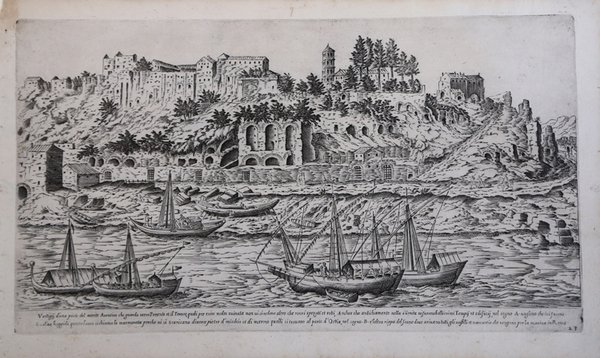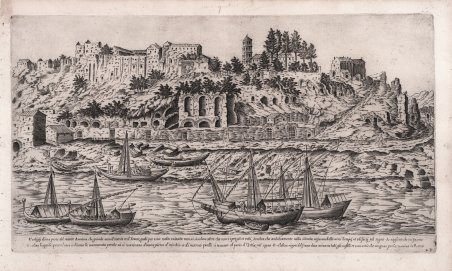Veduta tratta dall'opera I vestigi dell'antichità di Roma raccolti et ritratti in perspettiva da Stefano Du Perac parisino, pubblicata per la prima volta a Roma nel 1575 da Lorenzo Vaccari. Il volume consta di quaranta fogli tutti di tavole: il primo funge da frontespizio; nel secondo è ospitata la dedica a “Giacomo Buoncompagni governator generale di Santa Chiesa”. Étienne Du Pérac vi palesa le proprie intenzioni e in particolare sottolinea che “sarà dunque utile il libro […] et grato, et accetto agli studiosi dell’antichità per la diligenza che io ho usata in rappresentare fedelmente i residui della Romana grandezza”. Si affida poi all’ “autorità e virtù” del dedicatario perché possa favorire l’opera “bisognosa di molto lume” a causa dell’“oscurità dell’auttore”. In realtà, quando pubblica il libro, Étienne du Pérac è a Roma da oltre quindici anni, ed è noto se non altro per aver fornito la propria opera all’erudito veronese Onofrio Panvinio e aver dato alle stampe nel 1574 la pianta archeologica Urbis Romae Sciographia, ricostruzione topografica della Roma antica, cui sarebbe seguita, nel 1577, la pianta della Roma moderna, la Nova urbis Romae descriptio. Certo il mercato dell’editoria antiquaria era piuttosto affollato: nello stesso 1575 esce ad esempio per iniziativa di un altro francese, lo stampatore Antonio Lafreri (Antoine Lafréry), con il quale peraltro lo stesso Du Perac collabora, la raccolta iconografica Speculum Romanae Magnificentiae, che riunisce, incise da vari artisti, molte più immagini de I vestigi, non seguendo un’impostazione topografica e non, limitandosi agli edifici antichi ma inserendone di moderni nonché un repertorio di statue. Qui Du Pérac, partendo dal Campidoglio, scandisce il suo itinerario in trentanove tappe: in calce a ogni pagina una didascalia di poche righe fornisce le informazioni essenziali sugli edifici e le rovine. Non si tratta però di raffigurazioni di singoli monumenti, né tanto meno di ricostruzioni ideali, ma di vere e proprie vedute: immagini di grande qualità, paragonabili a quelle edite nel 1551 dall’incisore fiammingo Hieronymus Cock. Etienne Du Pérac o Duperac, nativo di Bordeaux o Parigi, si trasferisce presto a Venezia, dove apprende l’arte dell’incisione realizzando vari soggetti da Tiziano, principalmente per l’editore Giovanni Francesco Camocio. Arriva a Roma nel 1559 dove si dedica allo studio dell’architettura e delle antichità, con particolare attenzione alle opere di Michelangelo. A Roma conosce Onofrio Panvinio, archeologo ed antiquario, che lo influenza e lo introduce allo studio delle antichità romane. Come tutti gli artisti provenienti dal Nord Europa, rimane affascinato dalla maestosità delle rovine romane, decidendo di studiarle e raffigurarle. Le precedenti rappresentazioni dei monumenti di Roma, ad esempio quelle eseguite da Hieronimus Cock intorno al 1550, erano pittoriche ed arricchite da elementi di fantasia. La notevole importanza delle vedute di Roma del Duperac sta nel fatto che furono rappresentate con assoluta precisione archeologica e topografica, tanto da essere oggi studiate con grande attenzione dagli studiosi di archeologia, poiché spesso rappresentano monumenti e siti oggi andati perduti. L'opera ebbe ben 8 edizioni successive, alcune a cura della tipografia De Rossi. Incisione in rame, in ottimo stato di conservazione. View taken from the work I vestigi dell'antichità di Roma raccolti et ritratti in perspettiva da Stefano Du Perac parisino, published for the first time in Rome in 1575 by Lorenzo Vaccari. The volume consists of forty plates: the first serves as a frontispiece; the second contains the dedication to "Giacomo Buoncompagni governator generale di Santa Chiesa". Étienne Du Pérac expresses his intentions and in particular emphasizes that "the book [.] will therefore be useful and grateful, and accepted by scholars of antiquity for the diligence I have used in faithfully representing the remains of Roman grandeur". He then relies on the "authority and virtue" of the dedicatee so that he can encourage the work "in need of much light" because of the "obscurity of the author". When he published the book, Étienne du Pérac had been in Rome for more than fifteen years, and was known, if only for having supplied his work to the Veronese scholar Onofrio Panvinio and for having printed in 1574 the archaeological map Urbis Romae Sciographia, a topographical reconstruction of ancient Rome, which would be followed, in 1577, by the map of modern Rome, the Nova urbis Romae descriptio. Certainly the market of antiquarian publishing was quite crowded: in the same year 1575, for example, another Frenchman, the printer Antonio Lafreri (Antoine Lafréry), with whom Du Perac also collaborated, published the iconographic collection Speculum Romanae Magnificentiae, which brought together, engraved by various artists, many more images than I vestigi, not following a topographical approach and not limiting himself to ancient buildings but including modern ones as well as a repertoire of statues. Here Du Pérac, starting from the Capitol, outlines his itinerary in thirty-nine stages: at the bottom of each page a caption of a few lines provides essential information about the buildings and ruins. However, these are not representations of individual monuments, nor ideal reconstructions, but real views: images of great quality, comparable to those published in 1551 by the Flemish engraver Hieronymus Cock. Etienne Du Pérac or Duperac, born in Bordeaux or Paris, soon moved to Venice, where he learned the art of engraving by making various subjects from Titian, mainly for the publisher Giovanni Francesco Camocio. He arrived in Rome in 1559 where he devoted himself to the study of architecture and antiquities, with particular attention to the works of Michelangelo. In Rome he knows Onofrio Panvinio, archaeologist and antiquarian, who influences him and introduces him to the study of Roman antiquities. As all the artists coming from Northern Europe, he remains fascinated by the majesty of the Roman ruins, deciding to study and represent them. The previous representations of the monuments of Rome, for example those made by Hieronimus Cock around 1550, were pictorial and enriched with fantasy elements. The remarkable importance of the views of Rome by Duperac lies in the fact that they were represented with absolute archaeological and topographical precision, so as to be studied today with great attention by scholars of archaeology, since they often represent monuments and sites now lost. The work had 8 subsequent editions, some by the De Rossi printing house. Copper engraving, in excellent condition. Cfr.


Scopri come utilizzare
Scopri come utilizzare

